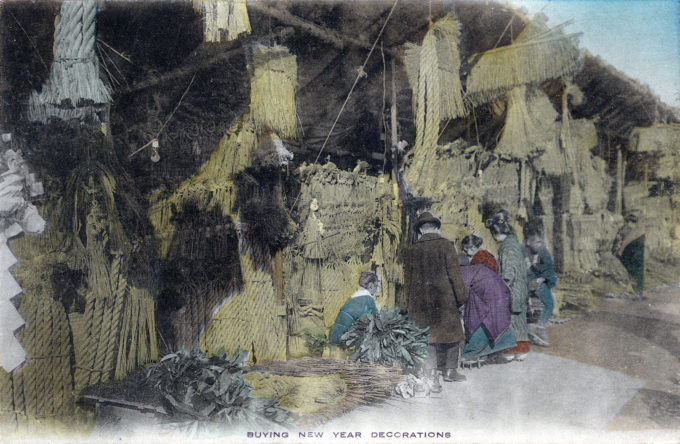“In January a festive spirit sweeps throughout the land. The New Year’s celebration is part and parcel of the heritage of every Japanese. It is the festival of festivals.
“During the first few weeks of the New Year, Japan is gay with the spirit of celebration. Kadomatsu stand before the entrances of various establishments. This bouquet of pine and bamboo symbolizes stability and righteousness. There is also the door decoration; a sort of valentine composed of straw rope (symbolizing unity), a daidai (a type of orange symbolizing long life for the family), fern (called uraziro or white back, denoting purity and fertility), a bit of seaweed (called kobu, and meaning happiness because of its similarity to yorokobu which means ‘to be glad’), and a paper or real lobster (symbolizing long life for members of the present generation).
“The people in most cities and towns are gay and lively, making calls on relatives and friends, and offering the greetings of the season. The idea of thanksgiving is strongly rooted in the minds of the Japanese, and many are the customs and rites which have their origin in this idea.
“In the Imperial court, early on the morning of January the First is held the august ceremony of Shihohai (literally, the ‘worship of the four directions’). The Emperor himself performs this ceremony, invoking ancestral aid for the peace and prosperity of the Empire. The Shihohai Day is one of the four great National Holidays, the other three being Kigensetsu [National Foundation Day], Tentyosetsu [the Emperor’s birthday], and Meijisetsu [the birthday of Emperor Meiji].
“This ceremony is performed in the silence and darkness of the early morning, in the flickering light of pine torches, even as the Imperial Ancestors performed it in the days of antiquity. After that, their Imperial Majesties receive in audience all the distinguished officials and foreign envoys privileged to offer their personal respects.
“So the vicinity of the Imperial Castle is thronged with civil and military officers, dressed in their glittering uniforms, as well as by thousands of people in holiday attire out to pay homage to the Emperor from outside the gate, as befits their humble status, and incidentally to see this procession of great personages going in and out of the Imperial Palace.”
– Annual Events in Japan, Japan Government Railways Board of Tourist Industry, 1900
See also:
Akemashite Omedetou (Happy New Year), c. 1910.
Ebisu, God of Good Fortune, New Year’s postcard, c. 1920.
Hanetsuki (Japanese Badminton), New Year’s cards, 1910 & 1939.
Dezome-shiki (“First event”), New Year’s Day, c. 1910 & 1960.
“Kado-matsu, literally meaning ‘pines at the entrance, form the chief feature of the New Year Decorations. Although other varieties of evergreens, such as bamboo, are used, the principal element of the decorations is the evergreen pine; hence the appellation.
“Toward the end of December every household in cities, towns or villages in Japan, gets busy in preparing for the coming of New Year. Among these preparations the most noteworthy one is putting up the kado-matsu. The significations of this embellishment are happiness, joy and auspiciousness.
“The kado-matsu consists chiefly of a pair of bundles of greenery, one at each side of the gate or front entrance of a dwelling or other building. These bundles may be made of pine alone, or with bamboo intermingled, and in size vary from a single pine bough, a few feet in length, to a large bamboo in the center with the pine branches around, ten or fifteen feet in height. The size, of course, accords with the class of people or household for which the decoration serves.
“An indispensable accessory to these evergreens is a bunch of twisted straw, looking very much like a piece of straw rope with fringed ends, which is known as shime. There is sometimes placed in the middle of the shime a decoration composed of a fruit of daidai, tachibana, yuzuri leaves, urajiro twigs, and either a red fish called tai or a prawn (ebi).
“The bamboo is usually used with its green foliage attached, but not infrequently it is stripped of its branches, and cut sharply at its top, leaving ten or twelve feet of stem, which is used as the core of the bundle. Large kado-matsu are planted in the ground, while small ones are nailed or tied to the pillars of gate or house.
“Each of the articles used in the decoration signifies something suggestive of luck, good omen or charm, suited to the propitious occasion which new hopes and happiness are ushered in.
“First and foremost, the pine leads all the evergreens, implying longevity and constant faith.
“It stands for thousands of years with its verdant needles, flourishing more and more as the year goes on. Besides being a symbol of unchangeable fidelity, the pine bespeaks strength and endurance, as it thrives in almost any place, soil or clime … Its trunk, too, looks like the body of a dragon, the fabulous noble animal of the Orientals, in the act, as it were, of ascending to heaven, a highly auspicious omen.
“[And] the belief prevails in some localities that the pine twigs, seven pieces by a man and two by a woman, gathered on New Year’s Day, possess the mysterious virtue of healing many otherwise incurable diseases.”
– Evergreen Decorations for New Year, by Yae-kichi Yabe, The Tourist, January 1921


